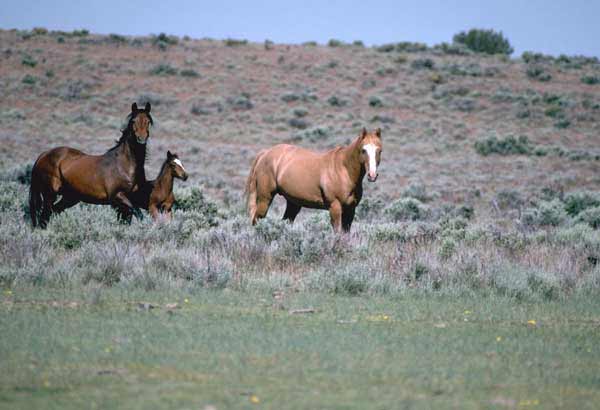U.S. Auctions Wild Horses Online

The Bureau of Land Management is running an online adoption of wild horses through July 30 in the ongoing effort to curb the burgeoning population of these surprisingly widespread beasts.
The creatures, which roam 10 Western states in 200 herds, have no natural predators and are protected by the federal government, resulting in "significant increases" in population, the BLM reports.
In total, the BLM manages about 40,000 wild horses. Smaller numbers are managed by other agencies. The tally is up from about 37,000 in 2005.
The agency has tried to curb the horse population by capturing and giving the equine equivalent of The Pill to 1,808 mares in 47 different herds since 2004, "but significant reductions in population increase have not been apparent."
Controversy
The BLM regularly runs in-person adoption events around the country. From 1971 through this June, more than 235,000 wild horses and burros have been adopted.
Critics charge that some people are not qualified to properly care for the adopted horses. Another issue: Some of the adopted horses have been known to end up at slaughterhouses.
Sign up for the Live Science daily newsletter now
Get the world’s most fascinating discoveries delivered straight to your inbox.
And the large number of horses waiting to be adopted are held in tight quarters that exposes them to disease and stress, animal rights advocates charge. Adoptions in recent years have declined and the number of horses in holding facilities has increased.
"BLM is seeking to counter this trend through better marketing of the adoption program," the agency states.
The adoption program, which requires a person meet several criteria related to animal care and shelter facilities, is explained here.
Wild horses?
North American horses died out around 11,000 years ago. Then domesticated horses were introduced to North America during the Spanish conquest. Some escaped and became wild again, eventually becoming the populations that roam free today. They long ago became a symbol of the American West.
The beasts typically inhabit arid grasslands and semidesert shrublands and sometimes woodlands with an understory of grasses out West. Smaller populations live on barrier islands off the mid-Atlantic coast.
They live tightly knit groups with one stallion, a lead mare and subordinate mares with their foals (offspring less than a year old). The typical group is about seven members, according to the BLM. The lead stallion protect his band and works to prevent rival males from stealing his harem.
The Wild Free-Roaming Horses and Burros Act of 1971 requires the wild horses be managed, protected, and controlled: "Congress finds and declares that wild free-roaming horses and burros are living symbols of the historic and pioneer spirit of the West; (and) that they contribute to the diversity of life forms within the Nation and enrich the lives of the American people."
The BLM monitors herd populations and determines how many animals, along with livestock and other wildlife, a certain area can support. Each year, it gathers "excess wild horses and burros from areas where vegetation and water could become scarce if too many animals use the area."
The agency spent $38.8 million on the wild horse and burro program last year. About $22 million of that was related to holding facilities. Budget problems loom: "Rising energy prices have increased costs and it is clear the agency cannot continue current removal and holding practices under existing and projected budgets," the agency states.
- The Surprising History of America's Wild Horses
- Video: Wild Horses of Mongolia with Julia Roberts
- Humans Might Have Wiped Out Wild Horses
Robert is an independent health and science journalist and writer based in Phoenix, Arizona. He is a former editor-in-chief of Live Science with over 20 years of experience as a reporter and editor. He has worked on websites such as Space.com and Tom's Guide, and is a contributor on Medium, covering how we age and how to optimize the mind and body through time. He has a journalism degree from Humboldt State University in California.










